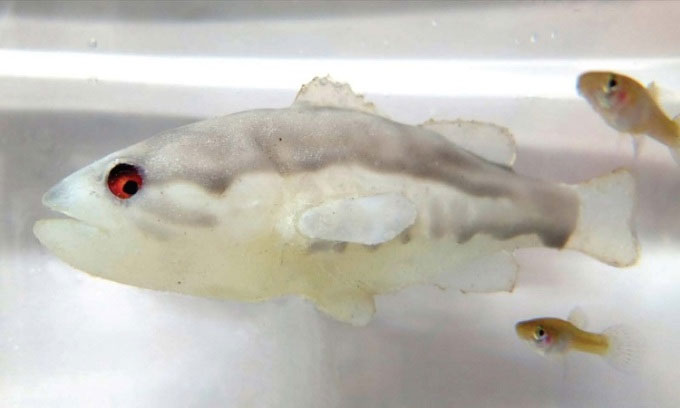Design a robot fish to repel invasive fish
Robot fish shaped like sea bass becomes the fear of mosquito fish (Gambusia holbrooki) - the species that causes the extinction of freshwater fish and native animals.
In a study published December 16 in the journal iScience, a team of researchers built a robot to repel fish and mosquitoes. They describe how fear changes the behavior, physiology and reproduction of mosquito fish, which could help control invasive species.

Robot fish (left) simulates sea bass which is the natural enemy of mosquito fish (left).
To deal with the invasive fish, an international team of biologists and engineers from Australia, the US and Italy relies on the mosquitofish's natural enemy, the broadmouth bass (Micropterus salmoides). They developed a robot fish that mimics the shape and movements of real sea bass. With the help of computer vision, the robot fish attacks when it sees the mosquito fish approaching the tadpoles of the species (Litoria moorei) which is threatened by mosquito fish in the wild. Overwhelmed by fear and stress, the mosquito fish exhibit wary behavior and experience weight loss, shape changes, and decreased fertility, all of which affect their ability to survive.
"Mosquito fish are one of the 100 worst invasive species in the world. Current methods of eradicating them are expensive and time consuming," said Giovanni Polverino, lead author of the study at the University of Western Australia. know. "This global pest is a serious threat to many aquatic animals. Instead of killing them individually, our approach provides a better way to control mosquito fish. We created this. develop a robot that can scare fish and mosquitoes but not affect other animals around."
In the presence of robot fish, the mosquito fish were usually closer together and spent more time in the center of the test area. In the environment outside the aquarium, the effect remains the same. The frightened fish was also less active, ate less and remained motionless for longer, showing signs of anxiety that persisted for weeks after encountering the robot.
For tadpoles, the food source of fish and mosquitoes, the presence of robots is more beneficial. While mosquito fish specialize in surveying the environment with their eyes, tadpoles have very poor eyesight. They can't see the robot well. Because the robot changes the behavior of mosquito fish, the tadpoles are no longer hunted by predators and are more willing to roam outside the test area.
After five weeks of interaction between the mosquito fish and the robot, the team found that the mosquito fish spent more energy running away than reproducing. The male fish's body becomes leaner and more elongated with stronger muscles concentrated in the tail. They also have lower sperm counts while females lay lighter eggs, affecting the survival of the species.
However, according to Maurizio Porfiri, a study co-author at New York University, the robot fish is not ready to be released in the wild. The team still needs to overcome many technical challenges. First, they plan to test the method in small ponds in Australia, where two endangered fish species are threatened by mosquitofish.
- USA invests in specially designed rescue robot
- Invention robot destroying lion fish
- The robot fish can swim at a depth of 15m without being detected
- Small fish, but 'weird' to fish eaters also abstain
- The first fish robot in Vietnam
- Robot fish can communicate directly with each other under water
- Snake robot can go to Mars
- 'Vampires' fish invade the lake
- The first fish swimming fast, swimming like fish
- Types of robots inspired by animals
- Italy successfully tested the first robot
- Why invasive species dangerous?
 The US company is about to build a supersonic passenger plane of 6,000km / h
The US company is about to build a supersonic passenger plane of 6,000km / h Japan develops avatar robot as in fiction film
Japan develops avatar robot as in fiction film Australia tested the world's first mango picking robot
Australia tested the world's first mango picking robot America develops technology to separate water from animal waste
America develops technology to separate water from animal waste